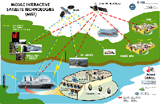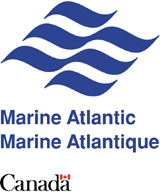
-
StatusCompleted
-
Status date2014-12-09
The MIST project had three specific elements that were implemented over the life of the initiative:
- The Wireless Sickbay
- The Wireless Kiosk (with a specific focus on tourism)
- Business Applications (Internet access)
The Wireless Sickbay element of the project developed, tested and implemented a telemedicine solution that can be fitted to a vessel (in this case the Marine Atlantic super ferry The Joseph and Clara Smallwood) to allow quick responses to medical problems from the RCST/IEMN network site in Port aux Basques, Newfoundland. This will see the creation of a technology, application, and human systems model that can be custom fitted to a vessel to meet its specific requirements.
The Wireless Kiosk element builds upon wireless community networking initiatives in Western Newfoundland (primarily in the Port aux Basques area) and focuses on the extension and expansion of tourism information and resources to events throughout the region through the combination of satellite and wireless facilities. As it would share a common network model with the Wireless Sickbay component of the project it would also provide the opportunity to develop a facility for real-time access to information and the Internet from a vessel, focused on public access facilities on vessels such as ferries to access tourism information and basic Internet services (this representing a possible future expansion of the project once the primary activities have been completed).
| <IMG alt="" src="/telecom/media/images/bl |
- Enhanced ability to respond to medical emergencies upon the ferry, with the development of a shore-side remote response capability that can be extended to other vessels
- The implementation of network-based tourism services and Internet for the travelling public on Marine Altantic's vessels
- The creation of a technology model that can be extended to other commercial marine operations for the provision of private or public network services
The facilities in Port aux Basques will be based upon a new C-band facility to be installed on-site at the Marine and Mountain Development Corporation. The existing high-speed wireless MAN will be used to provide conectivity to Marine Atlantic and the Hospital. The new earthstation is based upon the standard model developed by Telesat for the Smart Communities program. This model integrates BoD for high capacity applications such as video conferencing as well as asymetrical SCPC (64kbps Inboard and 768kbps outboard) facilities for full time Internet access.
A marine stable C band antenna (gyroscopically stabilized platform manufactured by Data Marine Systems in Scotland - Spactrac 4000) will be used to communicate with Port aux Basques and St. John's facilities. Under emergency conditions, the antenna will be used to communicate with any other site developed under the RCST/IEMN projects (also new sites under the SmartLabrador project) for services of medical experts if not available in PaB or St. John's at the time of the emergency. At this time of emergency other services may be affected. An second modem will also be provided to allow full-time access to Internet.
The vessel will be equipped with a dual WLAN radio, one antenna pointing forward (the bow) and the other backward (the stern). Each would operate at a different frequency to ensure RFI immunity. High gain parabolic antennas mounted on a steerable platform would be used on both the ferry and the port site. However, less directional antenna wide beam to account for variation in the ships course etc. would also be considered during the project. While close to port (Port aux Basques & North Sydney) passengers would have access to the North Sydney Server either locally over the WLAN or over a combination of the WLAN and the Internet (or the 128K Marine Atlantic leased line). Once at sea, the intelligence engine will initiate a satellite session with St. John's as require
Marine Interactive Satellite Technologies (MIST) builds upon the technologies and applications developed for the Remote Communities Services Telecentre (RCST) project and the Integrated Emergency Medicine Network (IEMN) projects. The MIST seeks to define, develop, implement and test emergency medical, business and tourism services on marine vessels. This could serve as the basis of a nation-wide land, air and sea emergency medicine network and also a business and teletourism for passengers in transit.
The MIST will define, develop and test the emergency medical care on water vessels and teletourism and business services for the passengers on board or for crew-focused business applications:
- Giving crew members (who may or may not be medical professionals) on the marine vessel direct and immediate access to emergency medicine physicians and resources within a province-wide network (with real-time video consultation and medical data transfer facilities).
- Allowing continuous communications and patient data transfer between emergency response staff on the marine vessel and the emergency facility during an emergency situation upon pending arrival of the patient to the seaport or air lifted from the vessel to the facility.
- Creating a teletourism facility on board the water vessel so that the passengers can access travel related data while boarding the vessel, in transit and upon arrival at the destination sea-port to plan their trips and make reservations for transport, accommodation, recreation facilities and like.
- Creating a business facility on board the marine vessel so that the passengers can access the worldwide web for e-mail, VoIP, and access to corporate offices.
To create this proof-of-concept MIST, the facilities will be implemented on the Marine Atlantic super ferry the Joseph and Clara Smallwood. This modern ferry will be assigned to the thirteen hour North Sydney - Argentina run during
The project has been completed. Read below for progressive status information.
The Mid Term Review was successfully completed (MTR) and became operational in mid-June 2002 on the Marine Atlantic ferry M.V. Joseph and Clara Smallwood. The Utilisation Phase continued until September 28th 2002, when the North Sydney to Argentina run concluded for the 2002 season (though the vessel continued on the North Sydney Port aux Basques run until late October prior to going into refit). Currently the system is operational on the Smallwood on the Port aux Basques run for the provision of Internet and Data services only.
All the network facilities have been installed and are operational on the vessel. This includes the stabilized 2.4m C-band satellite system (and associated electronics), as well as the sick bay facilities (based upon a Polycom H.323 video conference unit), three multimedia kiosks for the teletourism application, and a wireless access point for the provision of Internet services to the travelling public. Also developed for the project was the MISTMINDER server system, which provided coordination and management facilities for the various systems upon the vessel. An MSAT system has also been installed to provide an alternative voice communications channel, and consideration is being given to implementing a fee-based public phone service through the MSAT facility.
All training of medical support staff at the Port aux Basques hospital and on board the vessel has been completed, with the training covering both the technology being used and the service protocols to be followed. A series of regularly scheduled video consults was arranged between the vessel and the hospital (at least one per crossing) to provide an opportunity for ongoing familiarization and refinement of the sickbay application and usage protocols (this is in addition to any emergency consults that may occur). A data and feedback collection system was put in place at the hospital and on the vessel to acquire usage and user data for the evaluation of the service. Over the 2002 season a total of 23 sessions were conducted between the vessel and the hospital, including four live emergency consults (one other consult was done as a voice-only connection).
The Marine and Mountain Zone Corporation has been quite successful with the teletourism application this season, with over 200 companies and tourism operators subscribing to be represented with the teletourism database that is deployed on the vessel and in the terminal facilities. Based on the performance of the service this season planning is underway to expand the database to cover all of Atlantic Canada for next year s tourism season.
Internet services are being provided to the vessel's crew, as well as to the travelling public through the use of wireless facilities installed in one of the vessel s passenger lounges. To increase access to the service by the travelling public Marine Atlantic has installed several public Internet access kiosks that offer the service on a pay-as-you-go basis.
The MISTMINDER system allowed for the capture and transmission of real-time data from the vessel, including latitude/longitude, speed, heading, weather conditions, etc.). A number of possible applications are being considered for this, with the first one implemented being the real-time display of the vessel s position, speed and heading via a public web site.
The project is now complete and documentation will be released soon.







